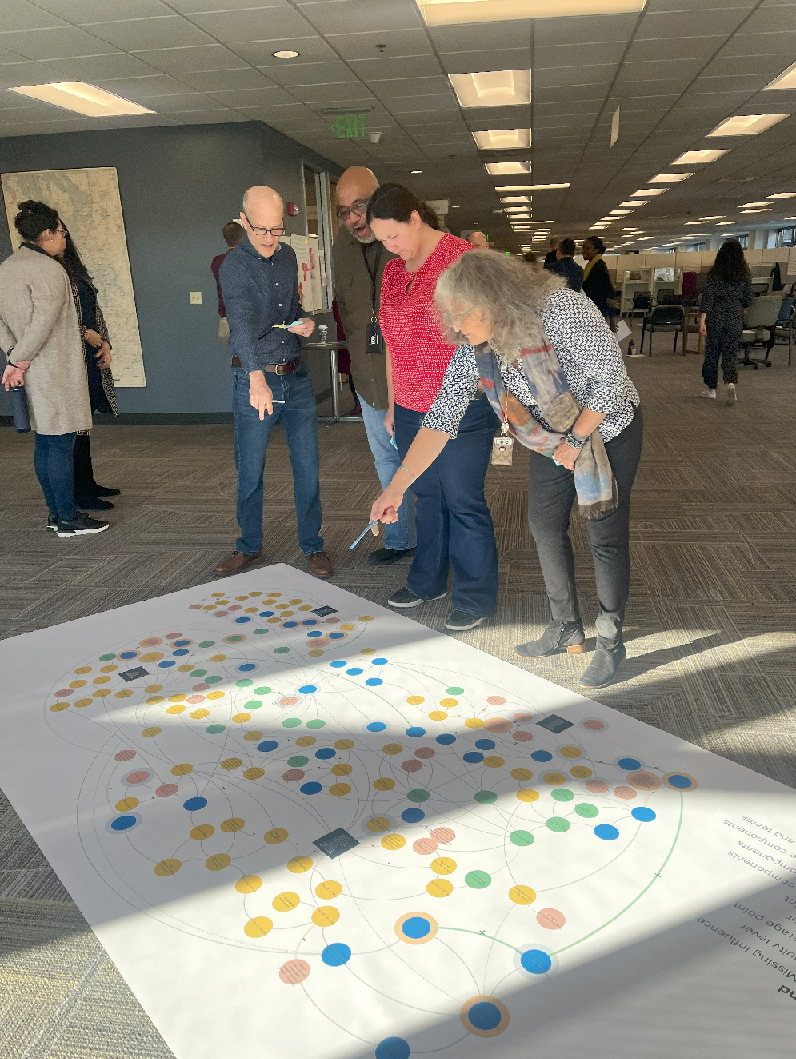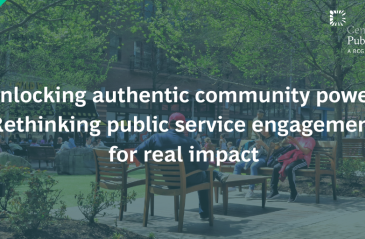
Move with intention: A Systems Innovation approach to zero emissions transit in King County, Washington


In partnership with @CPI_foundation, @KingCountyMetro has embarked on a journey to understand its existing system and identify required changes to propel it toward the future.
Share article.@KingCountyMetro & @CPI_foundation are using a systems innovation approach to learn about what is needed for a successful net zero transition. Explore what they learned.
Share article"The system map helps us understand interrelationships. When we’re talking about making a decision in some area, where else do we need to understand the risks & values of changes we make?" - David Eldred from @KingCountyMetro
Share articleWe put our vision for government into practice through learning partner projects that align with our values and help reimagine government so that it works for everyone.
This is the second blog in a multi-part series on the Centre for Public Impact’s (CPI) partnership with King County Metro (Washington State’s public transit agency serving Seattle and King County) as they bring a systems innovation approach to their zero-emissions goals. The first part of this series was published in January 2024. To follow along as we learn in the open together, subscribe for updates.
Imagine sitting on a bus during your daily commute. The bus feels new - it still has that “new car” smell you are fond of. The motor is even quieter than usual. When you reach your destination and exit the bus, you notice there isn’t an exhaust pipe. Then you see lettering on the bus announcing that it is one of the county’s new electric buses. This makes you smile. You are happy to reduce your daily greenhouse gas emissions and that your county is making positive environmental change.
Putting a new type of bus on the road might seem as simple as finding a seller and purchasing the vehicle of choice. However, countless behind-the-scenes decisions must be made to get it there. Especially if the types of buses vary as much as diesel hybrid buses and electric buses do - with different fuel sources, safety risks, infrastructure needs, and operational capabilities. The difference between these two types of vehicles is so fundamental that transitioning from a diesel hybrid fleet to zero emissions requires a wholescale effort in which connections must be made between many actors and components of a transit agency.
This is what King County Metro is doing to transition to a zero emissions (ZE) bus fleet. Metro has recognized that its internal operations must also innovate in the face of this upcoming change.
In partnership with CPI, Metro has embarked on a journey to understand its existing system and identify required changes to propel it toward the future.
Metro and CPI are using a systems innovation approach to learn about the organization and what it needs for a successful transition. This approach requires us to look at Metro as a whole rather than focusing on individual parts in isolation. It focuses on underlying dynamics, mental models, and conditions to enable adaptiveness and transformative change. By looking at the interconnections and relationships between the elements of Metro, we can observe how changes in one part can affect the entire agency.
“I believe that this work is critical in level setting everyone and showing how their role influences and affects each other and the transition.” Huoi Trieu, Zero Emissions Director, King County Metro
Systems mapping is a powerful process that can help Metro uncover major pain points that may be hindering its operations and opportunities that can enhance the organization’s capabilities as it focuses on the ZE goal. To develop a system map, CPI and Metro conducted workshops with Metro divisions and teams, interviewed staff, and hosted an in-person fair where more than 200 staff could learn what other divisions were doing to prepare for the transition. Insights were drawn from each step with support from Daylight, a consulting firm with expertise in systemic design. These insights helped identify underlying connections between policies, practices and resource flows, relationships and power dynamics, and mindsets. These six elements represent conditions that, if shifted, can lead to systems change, according to FSG’s Water of Systems Change framework.
The Metro ZE transition system maps and contextual analysis are dynamic tools that will enhance Metro’s ability to learn and adapt. Each tool was treated as a living document that we continued to update with new information following each set of activities. These tools were introduced to staff as supplementary resources that could support them in thinking about their roles, embracing Metro’s complexity, and finding opportunities to adapt to the changes expected with the ZE transition. We emphasized that the maps may not fully reflect everyone’s experiences and encouraged staff to continue thinking about how different aspects of Metro could be linked to create new ways of working.
"The system map helps us to understand interrelationships. When we’re talking about making a decision in some area, where else do we need to go to understand the risks and values from any changes that we make?" - David Eldred, General Counsel, King County Metro
Through the systems mapping process, we uncovered numerous insights into Metro’s opportunities and challenges as it continues its zero emissions journey. Highlights include:
Significant connections were forged by bringing together individuals who typically do not have a chance to interact. For example, during a systems mapping workshop, an engineer from Capital Division was able to connect with an employee from Community Engagement and Government Relations on collaborating to garner jurisdictional support for infrastructure development. Furthermore, sessions and discussions facilitated a broader understanding of the diverse experiences within the organization and promoted cross-functional insights beyond departmental boundaries. This enabled participants to view challenges and opportunities through a systemic lens, fostering the ability to discern interconnections independently.
 Metro staff discussing the draft system map during a project workshop
Metro staff discussing the draft system map during a project workshop
Given the high stakes of climate change, there is a fear that there is no time to fail, even though many recognize failure as an opportunity to learn. Furthermore, the fear surrounding the transition is amplified by uncertainties about electric bus technologies and necessary tradeoffs for decision-making. For example, there remain outstanding questions about the maturity of battery technologies, their on-road reliability, and how required charge times would affect route planning. Underlying fear and uncertainty limits people’s ability to take risks and innovate. Successful completion of the organizational goal requires leaders to continue demonstrating their increased willingness to take risks and embrace experimentation as opportunities to learn and adapt.
We unearthed a traditionally linear way of working in which emergent needs are addressed through sequential steps with limited cross-team dialogue and input. Furthermore, outside of leadership levels, staff in different divisions and teams do not have many opportunities to collaborate and discuss their varying work streams. The poster fair and other cross-division sessions created valuable opportunities for Metro staff to come together to start learning about different roles, risks and opportunities, and possibilities for working together. 90% of respondents agreed they felt more connected with other divisions and built lasting relationships after the poster fair. There needs to be continued efforts to dismantle structures of work that reinforce existing silos and promote collaboration to effectively assess and manage risks.
Many staff and leaders can see Metro’s big-picture goals and recognize connections between their work, other teams’ roles, and Metro’s overarching objectives. Moreover, they can recognize that not practicing systems thinking could have negative outcomes. One interviewee noted that "so often Bus Operations gets a project dropped on them, and they don't know anything about it. They see flaws in it right away, but by that time, it's too late." By expanding this type of thinking, teams will be better able to identify challenges, opportunities, shared values, and a cohesive vision that helps to effectively enable the ZE transition.
The system mapping outcomes will inform the development of a joint mission and vision statement by all Metro divisions and teams, as well as a list of commitments that will guide actions taken to achieve the ZE transition.
If you are curious about this work, we invite you to join us on this journey. We’ll be publishing periodic updates alongside our partners at King County Metro. Sign up to receive updates on this work and our progress. We look forward to sharing what we learn and hearing from you as we progress.






